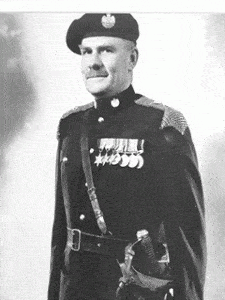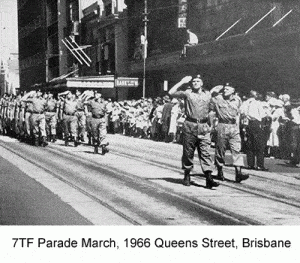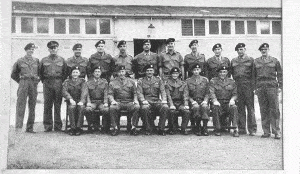COLONEL F. J. (BILL) MORGAN ED
15.12.1917—8.7.2001
 Franklin James Morgan, Bill as he was affectionately known, was a “big man” in every sense. He cut an imposing figure, matched by sterling qualities of character. This story is not a biography, but it is an attempt to record for posterity something of the life of the man as some of us knew him. I have drawn heavily from a tribute written 24th July 2001 by Col Harrington, President of the 2nd/7th Aust Cavalry Regiment Association, and anecdotal evidence provided by Major Len Friend ED RFD, and Captain Lancelot Lawlor, ED, both of whom served under Bill in 2nd/14th Queensland Mounted Infantry. I must also acknowledge the help given me by Lieutenant Desmond Woods, OIC Naval History, and Librarian Clare Steve at HMAS Creswell.
Franklin James Morgan, Bill as he was affectionately known, was a “big man” in every sense. He cut an imposing figure, matched by sterling qualities of character. This story is not a biography, but it is an attempt to record for posterity something of the life of the man as some of us knew him. I have drawn heavily from a tribute written 24th July 2001 by Col Harrington, President of the 2nd/7th Aust Cavalry Regiment Association, and anecdotal evidence provided by Major Len Friend ED RFD, and Captain Lancelot Lawlor, ED, both of whom served under Bill in 2nd/14th Queensland Mounted Infantry. I must also acknowledge the help given me by Lieutenant Desmond Woods, OIC Naval History, and Librarian Clare Steve at HMAS Creswell.
Bill was born in Toowoomba, no doubt when his father was managing a branch of the National Bank [Bill’s father retired as State Manager of that Bank]. He attended Eagle Junction State School before going on to Churchie [now the Anglican Grammar School] in the days of its founder Cannon Morris. From school he joined the Commonwealth Bank, and apart from the war years remained with that Bank until his retirement. It was his only ‘civvy’ employer. He was a keen sportsman, favouring Rugby and Rowing, and representing Queensland in the Kings Cup in 1938.
In 1938 he joined 2nd/14th Light Horse Regt, a militia unit still using horses—so Bill was a true “Light Horseman”. He was posted to the Signal Troop, which was being raised by Capt Alan Muir, at that time ADC to Sir Leslie Wilson, State Governor.
When WWII broke out Bill attended two Light Horse camps; the second was at Beaudesert of three months duration. He was now a Sergeant at Brigade HQ, commanded by the renowned ‘Bull’ Monaghan. He carried this rank when he joined the AIF—2nd/7th Aust Cavalry Regt, with Regimental Number QX 760. The 2nd/7th was an armoured unit equipped with Bren-gun Carriers and Light Tanks.
The Regiment sailed from Sydney in December 1940 on the Queen Mary—destination the Middle East. Here the Regiment saw service in Palestine, Egypt, Cyprus, Syria, and Lebanon. His outstanding leadership qualities were soon recognised, and in April 1941 he attended the Officers School at Maadi in Egypt.
He topped his course, was commissioned Lieutenant, and received the Allenby Award.
 With the Japanese now in the war, and threatening Australia, the Regiment returned home with the 6th and 7th Divisions, in March 1942. They now trained as infantry ready for jungle warfare, and fighting the Japs. This training was carried out initially at Gawler, in South Australia, then at Glen Innes, and finally in coastal areas North of Brisbane. There is an amusing anecdote which Col Harrington tells: “About this time Bill’s sister Jean, back home, entered his photo in the ‘Pix’ Magazine competition for a 50 pounds AIF smile. It won! Bill received lots of ribbing from his mates but he handled it very well.”
With the Japanese now in the war, and threatening Australia, the Regiment returned home with the 6th and 7th Divisions, in March 1942. They now trained as infantry ready for jungle warfare, and fighting the Japs. This training was carried out initially at Gawler, in South Australia, then at Glen Innes, and finally in coastal areas North of Brisbane. There is an amusing anecdote which Col Harrington tells: “About this time Bill’s sister Jean, back home, entered his photo in the ‘Pix’ Magazine competition for a 50 pounds AIF smile. It won! Bill received lots of ribbing from his mates but he handled it very well.”
It is now September 1942, and the Regiment finds itself in New Guinea, continuing its training at Port Moresby. In mid December they were air lifted over the Owen Stanley Range, and went into action at Sanananda near Buna. The fighting was intense and the conditions intolerable. Over the next four weeks they sustained heavy casualties—out of a strength of fewer than 400 there were 57 members killed and 69 wounded. Of the survivors, most suffered from malaria, and other tropical diseases.
The remnants of the Regiment returned to the Atherton Tableland early 1943 to recover. However, the Regiment was not reformed, and its men transferred to other units to continue the war. Bill joined FELO, the Far East Liaison Organisation. For good reasons not much is known about FELO, and I am indebted to Colonel Arthur Page, and the late Major Syd Appelby for supplementing information that I had gleaned from Bill himself.
Among its clandestine operations FELO was engaged in propaganda and psychological warfare. Bill would be flown by flying boat into the back blocks of New Guinea, eg around the Finschafen-Madang axis. A radio operator and sometimes a Native Policeman accompanied him. After three months or earlier if the Japs had been stirred up, they were pulled out—half starved and riddled with malaria. After some R&R they went back in. They were brave men!
He finished the war as a Major, and when the CMF was started he remained with the Intelligence Corps. His service included appointments on the Intelligence Staff of HQ Northern Command, where his final posting was as a Lt Col, GSO1 Int. During this period he also commanded 3 Interrogation Unit. During this time he intervened to resolve some bureaucratic nonsense to help Arthur Page achieve his First Appointment as Lieutenant. Arthur, a veteran of WWII, and an experienced linguist (Japanese), went on to reach the rank of Colonel. This story is told to illustrate how Bill would go out of his way to help someone with a problem.
He then took some leave before being recalled to take command of 2nd/14th Queensland Mounted Infantry, now 2nd/14th Light Horse Regiment (Queensland Mounted Infantry)—at last he was back with his first Regiment.
His leadership was unquestioned, instilling a sense of purpose in all ranks, and promoting the heritage of the Regiment. He cared for his men, and took a real interest in their families—the Regiment was their home.
He was successful in having Sir Alan Mansefield, then Governor of Queensland, appointed Honorary Colonel, succeeding him in 1972 in that position, continuing until 1978. He provided useful guidance and support to Brigadier Colin Wilson OAM, ED, RFD when he commanded the Regiment. In 1973 it became my good fortune to enjoy this same support.

Annual Camp May 1966
Back Row: Lt. G. R. Allman, Capt. E. Perry, Lt. E.M. Haig, Capt. F. Lamb, Lt. M.M. O’Donnell, Lt. N.R. Ritchie, Lt. R. McNae, Lt. G. Tregenza, Lt. L. Frank, Capt. A. Davidson (RAAMC) & Lt. D.J. Haldon Hodge.
Front Row: Capt. L. Friend, Capt. T. Edmistone, Capt. B. Barrott (ADJT), Lt. Col. F. J. Morgan (CO), Maj. W.H.F. Duff, Capt. R. Burn & Capt. K. Mason (QM).
We travelled many miles together—up and down to the training area at Tin Can Bay, and out to Charleville for Exercises with 4 Cav Regt. During this travel we talked about many life issues, and he gave wise counsel. In the field he showed a keen interest in what the Troops were doing, and would readily join in their activities. He proved to be a good shot with the 106 RCL. He enjoyed his soldiering, and his presence always uplifted the spirits of the men.
When Honorary Colonel in 1974, he and Major Syd Appelby (retired, but the conscience of the Regiment) were instrumental in persuading Clem Jones, then Lord Mayor of Brisbane, to grant the Regiment the Freedom of the City of Brisbane. It was the first parade on the new King George Square, and a signal honour.
In his retirement from military service he retained his interest in Regimental activities. For a time he was Patron of the Royal Australian Armoured Corps Association (Qld Branch), and also Patron of 2nd/7th Aust Cavalry Regt (Qld) Association. During his travels in South Africa he visited Sunnyside Kopje where the first soldiers of the Regiment were killed on 1 January 1900, indeed they were the first Australian soldiers killed in the Boer War. He established contact with the Dugmores, whose forebears farmed this area. This contact remains firm to this day.
Bill was active in his community—a keen Lawn Bowler, Treasurer of the Queensland Society for Crippled Children, and Grand Master of the Masonic Lodge in Queensland, to mention a few of his many commitments.
His dear wife Clare survived him for a little over one month, an indicator of the love they had for one another. Bill and Clare were married by Canon Morris in the Chapel at Churchie just before he sailed for the Middle East. They had six children, but sadly survived by only three. Midshipman F.J. (Frank) Morgan was ‘Lost at Sea’ following the collision between the HMAS Voyager and HMAS Melbourne on 10th February 1964.
The Morgan’s joined with parents of other Midshipmen who had been lost at sea to present a Memorial Sword to honour those Midshipmen. It was for use at HMAS Creswell, the Royal Australian Naval College at Jervis Bay, NSW. The current status of the Sword is best told by quoting from the words used at Passing Out Parades of New Entry Officers:
“REAR ADMIRAL HAMMOND MEMORIAL SWORD.
The prize of a Memorial Sword was established in 1964 by the parents of eight Navy junior Midshipmen who lost their lives in accidents, four in a boating accident off HMAS Sydney in the Barrier Reef in 1963, and four in the Voyager and Melbourne collision in 1964.
It was first awarded to Midshipman Hammond, who became a Weapons Electrical Officer, served in numerous ships; saw active service in Vietnam, and became a Rear Admiral in 1992.
The Sword was returned to the College by Admiral Hammond before his comparatively early death from illness in 2003.
The Sword is awarded to the NEOC graduate who has been distinguished by self discipline, resolution, undeviating application and good influence among his or her peers.”
To complete the story, the Midshipmen who lost their lives were:
1963 – D.J. Sanders, G.J. Pierce, B.M. Haywood, P.G. Mulvaney [SBLT N.J. Longstaff RANR also lost his life in this incident]
1964 – K.F. Marien, B.C.L. Lindsay, R.W. Maunder, F.J. Morgan
I have given this matter some attention because, quite naturally, it was of great significance to Bill and Clare. It will help ensure that those brave young men, who gave their lives while training to defend Australia, will be remembered, and honoured as the Morgans and the other parents would wish. What a sad loss of men so young.
Attending the Passing out Parades at HMAS Creswell each year was an important occasion for them. Bill did not often speak about their tragic loss, but mentioned once how grateful he was when the Navy, some years later, took them on a Destroyer to the site of the collision for a Memorial Service. It was a point of closure for him.
I do hope that this article will cause readers to recall memories of a great man that they once knew, respected and loved.
Lt-Col Miles W Farmer OAM (retired)
